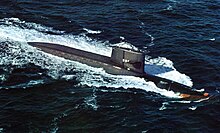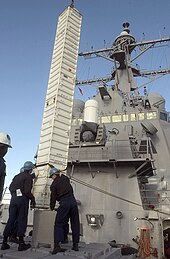
Back نظام إطلاق عامودي Arabic Установка за вертикален пуск Bulgarian Sistema de llançament vertical Catalan Vertikální odpalovací zařízení Czech Vertical Launching System Danish Senkrechtstartanlage für Flugkörper German Sistema de lanzamiento vertical Spanish سیستم موشکانداز عمودی Persian Système de lancement vertical French מערכת שיגור אנכי HE
This article needs additional citations for verification. (January 2017) |





A vertical launching system (VLS) is an advanced system for holding and firing missiles on mobile naval platforms, such as surface ships and submarines. Each vertical launch system consists of a number of cells, which can hold one or more missiles ready for firing. Typically, each cell can hold a number of different types of missiles, allowing the ship flexibility to load the best set for any given mission. Further, when new missiles are developed, they are typically fitted to the existing vertical launch systems of that nation, allowing existing ships to use new types of missiles without expensive rework. When the command is given, the missile flies straight up far enough to clear the cell and the ship, then turns onto the desired course.
A VLS allows surface combatants to have a greater number of weapons ready for firing at any given time compared to older launching systems such as the Mark 13 single-arm and Mark 26 twin-arm launchers, which were fed from behind by a magazine below the main deck. In addition to greater firepower, VLS is much more damage tolerant and reliable than the previous systems and has a lower radar cross-section (RCS). The U.S. Navy now relies exclusively on VLS for its guided missile destroyers and cruisers.
The most widespread VLS in the world is the Mark 41, developed by the United States Navy. More than 11,000 Mark 41 VLS missile cells have been delivered, or are on order, for use on 186 ships across 19 ship classes, in 11 navies around the world. This system currently serves with the US Navy as well as the Australian, Danish, Dutch, German, Japanese, Norwegian, South Korean, Spanish, and Turkish navies, while others like the Greek Navy preferred the similar Mark 48 system.[1]
The 3S-14 VLS was developed in Russia and is used in sea-based as well as land-based TEL systems such as the S-400 missile system.[citation needed]
The advanced Mark 57 VLS is used on the Zumwalt-class destroyer. The older Mark 13 and Mark 26 systems remain in service on ships that were sold to other countries such as Taiwan and Poland.
When installed on an SSN (nuclear-powered attack submarine), a VLS allows a greater number and variety of weapons to be deployed, compared with using only torpedo tubes.
- ^ Preview ofTable of contents (2016-07-08). "Naval Swiss Army Knife: MK 41 Vertical Missile Launch Systems (VLS)". Defenseindustrydaily.com. Archived from the original on 2016-12-30. Retrieved 2016-12-29.